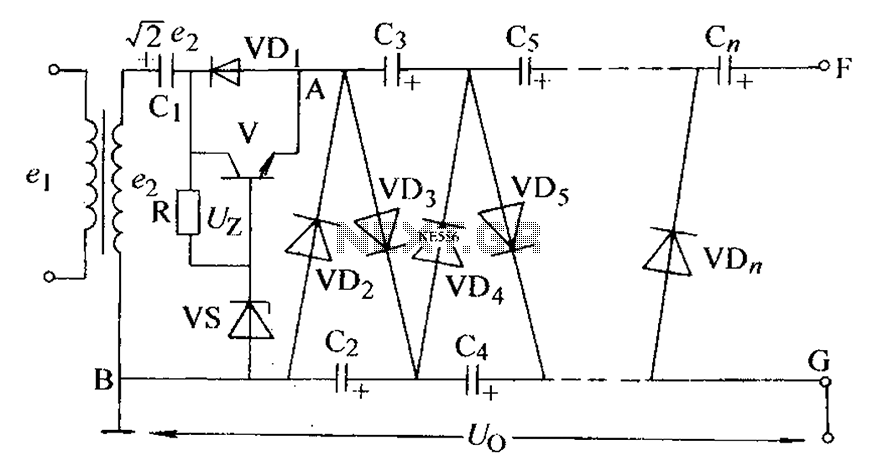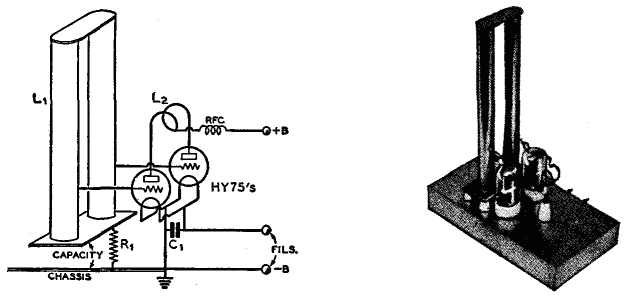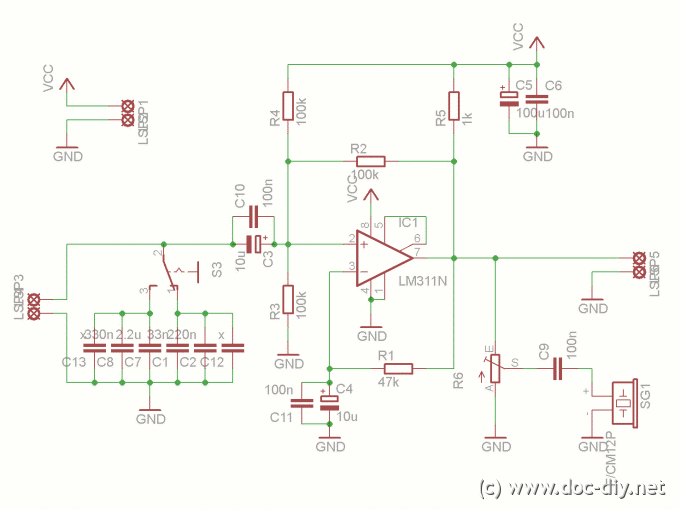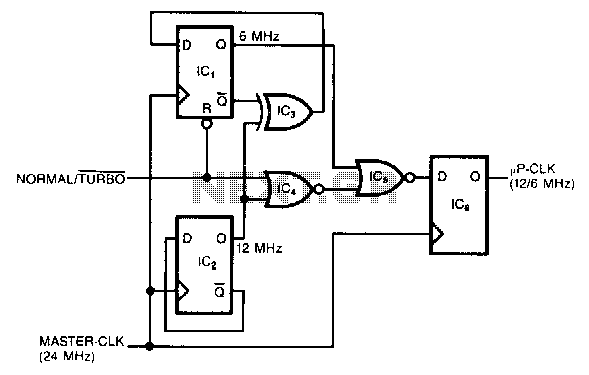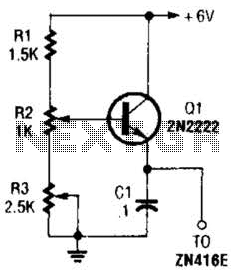
555 meter circuit diagram of a DC voltage

The control terminal at 5 feet and the threshold end at 6 feet represent two internal input voltage comparators. As long as the voltage at 6 feet exceeds the voltage at 5 feet by 5 mV, the 555 timer will reliably trigger. By applying a DC voltage to the specified terminals, if the voltage is high, LED1 will illuminate; if the voltage is low, LED2 will illuminate. The measurement range can be adjusted using RP1, and when the two LEDs alternately flash, the range indicated by RP1 corresponds to the measured voltage. The device has four measurement ranges: 0-1V, 0-10V, 0-100V, and 0-1000V.
The described circuit utilizes a 555 timer integrated circuit configured in a comparator mode to detect and compare input voltage levels. The control terminal (5 feet) is connected to a reference voltage, while the threshold terminal (6 feet) receives the input voltage to be measured. The internal comparators of the 555 timer will trigger an output when the voltage at the threshold terminal exceeds the reference voltage by a small margin, specifically 5 mV.
When a DC voltage is applied across the designated terminals, the circuit is designed to illuminate LED1 when the input voltage is above the reference level and LED2 when it is below. This visual indication provides immediate feedback on the voltage level being measured.
The resistance value of RP1 can be adjusted to modify the sensitivity of the measurement. As the resistance changes, the range of voltage that can be effectively measured is altered, allowing for a versatile application across different voltage levels. The alternation of the two LEDs serves as an indicator of the current measurement range, with the specific range being determined by the setting of RP1.
The voltage measurement ranges are clearly defined as follows: 0-1V for low voltage applications, 0-10V for moderate voltage scenarios, 0-100V for higher voltage measurements, and 0-1000V for very high voltage applications. This multi-range capability makes the circuit suitable for various electronic testing and monitoring tasks, ensuring that it can accommodate a wide spectrum of voltage levels while providing reliable and accurate readings. As shown, the control terminal 5 feet and 555 threshold end 6 feet is actually two internal input voltage comparator I, as long as 6 feet voltage is higher than 5 feet 5mV, the n 555 will reliably trigger. Applying a DC voltage to the figure of + - terminal, if the voltage is high, LED1 light; low voltage, LED2 light. Change the range and RP1, when the two alternately flashing arc tube, the range is multiplied by RP1 indicators, is the measured voltage V number.
Fourth gear measuring range: 0-1V, 0-10V, 0-100V, 0-1000V.
The described circuit utilizes a 555 timer integrated circuit configured in a comparator mode to detect and compare input voltage levels. The control terminal (5 feet) is connected to a reference voltage, while the threshold terminal (6 feet) receives the input voltage to be measured. The internal comparators of the 555 timer will trigger an output when the voltage at the threshold terminal exceeds the reference voltage by a small margin, specifically 5 mV.
When a DC voltage is applied across the designated terminals, the circuit is designed to illuminate LED1 when the input voltage is above the reference level and LED2 when it is below. This visual indication provides immediate feedback on the voltage level being measured.
The resistance value of RP1 can be adjusted to modify the sensitivity of the measurement. As the resistance changes, the range of voltage that can be effectively measured is altered, allowing for a versatile application across different voltage levels. The alternation of the two LEDs serves as an indicator of the current measurement range, with the specific range being determined by the setting of RP1.
The voltage measurement ranges are clearly defined as follows: 0-1V for low voltage applications, 0-10V for moderate voltage scenarios, 0-100V for higher voltage measurements, and 0-1000V for very high voltage applications. This multi-range capability makes the circuit suitable for various electronic testing and monitoring tasks, ensuring that it can accommodate a wide spectrum of voltage levels while providing reliable and accurate readings. As shown, the control terminal 5 feet and 555 threshold end 6 feet is actually two internal input voltage comparator I, as long as 6 feet voltage is higher than 5 feet 5mV, the n 555 will reliably trigger. Applying a DC voltage to the figure of + - terminal, if the voltage is high, LED1 light; low voltage, LED2 light. Change the range and RP1, when the two alternately flashing arc tube, the range is multiplied by RP1 indicators, is the measured voltage V number.
Fourth gear measuring range: 0-1V, 0-10V, 0-100V, 0-1000V.
